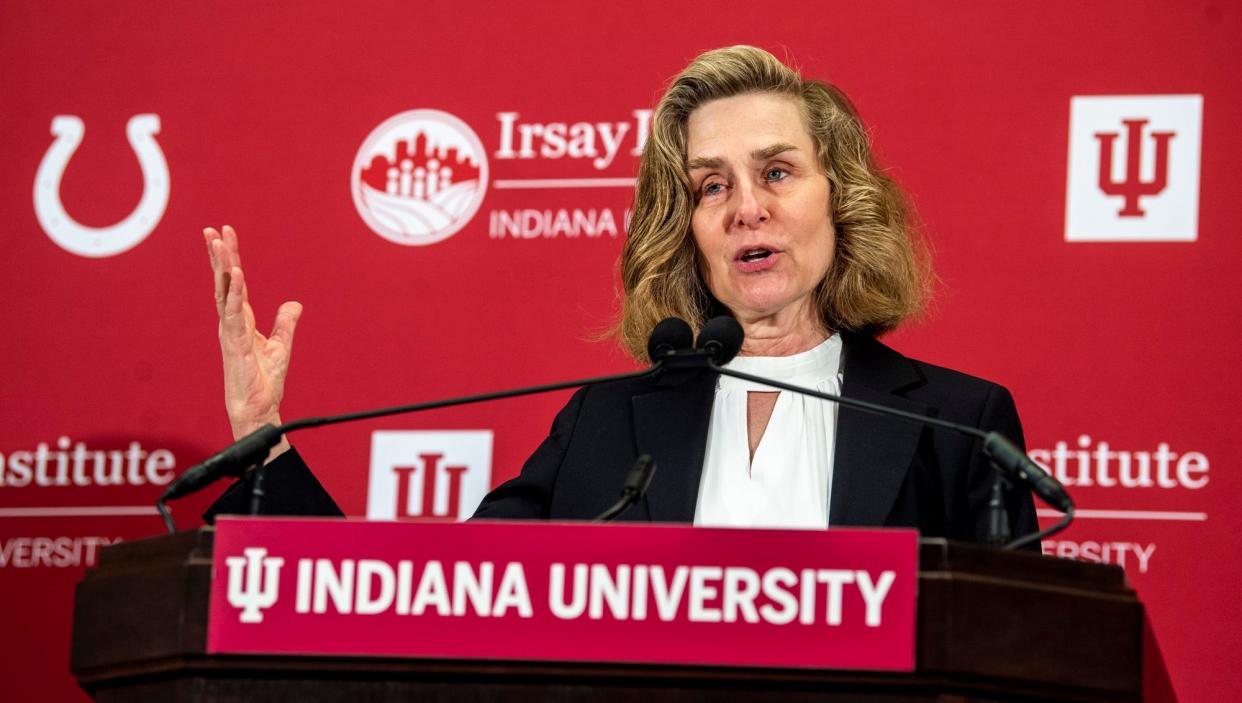Hundreds of Indiana University faculty members vote 'no confidence' in Whitten

Members of the Indiana University Bloomington faculty overwhelmingly voted “no-confidence” in President Pamela Whitten, Provost Rahul Shrivastav and Carrie Docherty, vice provost for faculty and academic affairs Tuesday evening.
In attendance were 948 faculty members for the vote at the IU Auditorium, well over the threshold needed to reach quorum, at 800. As a result, the attending votes were considered the formal “opinion of the faculty.” The total number of eligible faculty to vote at the special meeting was 3,276, meaning less than 30% of eligible faculty participated in the vote.
There were 827 faculty members who voted in favor of the no-confidence motion against Whitten (93%), while 29 voted against and 32 abstained.

For Shrivastav, 879 voted in favor of the no-confidence motion (91%), while 47 voted against and 28 abstained.
Docherty received 672 votes of no-confidence (75%), while 107 voted against and 116 abstained.
Why did IU faculty take a no confidence vote?
On Mar. 27, more than 200 faculty members signed a petition calling for a special meeting to hold a vote of no confidence against Docherty, Shrivastav and Whitten. The petition centered around the administration “encroaching on both academic freedom and shared governance.”

Key examples included Docherty’s suspension of professor Abdulkader Sinno without a hearing from the Faculty Misconduct Review Committee, the administration’s cancellation of Palestinian artist Samia Halaby’s exhibit at the Eskenazi Museum of Art, the administration’s handling of controversial Senate Bill 202 (which restructured the tenure process at Indiana public universities), their rescinded attempt to sever the Kinsey Institute into a 501(c)(3) nonprofit and their refusal to publicly defend faculty member Dr. Caitlin Bernard against Indiana Attorney General Todd Rokita after he questioned her medical credentials for performing an abortion for an Ohio rape victim.
Sinno said the administration’s flippancy toward shared governance policies demonstrates the current administration is unfit to lead a major research university.
“I’ve had disagreements with administrations in the past, but we all, them and I, respected policies,” Sinno said. “This administration has no respect for policies or the values of Indiana University.”
How did the IU administration respond to the no confidence vote?
Following the no-confidence vote, Whitten put out a statement emphasizing the “challenging societal moment” facing higher education and the need for “difficult but necessary decisions” to ensure IU remains an elite research university.
“While we will not always agree, our community is made stronger by an array of viewpoints and voices — including those expressed as part of this process,” Whitten said. “As we plan our future together, I encourage you to suggest innovative opportunities within your department, school or college to share your ideas. In turn, I pledge to listen and learn. I will weigh the guidance from faculty council and the participation of the campus community through shared governance to achieve our collective vision of a thriving campus.”
Whitten did not address any administration controversies by name and focused instead on the IU 2030 strategic plan and the need for collaboration between the administration and faculty.
The Board of Trustees also released a statement affirming their support for Whitten. Their statement also focused on the IU 2030 strategic plan and the need for collaboration and “shared respect” during an “unprecedented” moment in higher education.
“IU 2030 is the roadmap for IU’s continued growth and sustained excellence, and President Whitten’s leadership is key in delivering the results required,” the statement read. “She is the right leader at the right time precisely because she has pursued a future for Indiana University that will ensure that it thrives in its next era. It is our intention that President Whitten's tenure as the leader at IU will provide the many years necessary to realize the vision we have established for the university.”
Trustees chair Quinn Buckner also released a statement in support of Whitten.
“Let me be absolutely clear: President Whitten has my full support and that of every member on the Board of Trustees,” Buckner said. “I have the privilege of working hand in hand with her and I regularly witness her deep integrity, compassion and commitment to IU's future. She is an extraordinary leader who is crucial to Indiana University’s success and will be serving as our president for years to come.”
What happens next?
No-confidence votes wield no executive power to remove administration members and are instead meant to signify dissent to the administration and stakeholders like the Board of Trustees.
A study from the Journal of Research on the College President found that no-confidence votes in higher academia resulted in a presidential leadership change more than half of the time.
These changes most commonly stem from voluntary resignations, as was the case for IU President Adam Herbert, who declined to renew his contract after an informal straw-poll from faculty members asked the IU trustees to review his leadership.
No-confidence votes can also precede trustee removals, like when the University of Illinois-Chicago board declined to renew Chancellor Paula Allen-Meares’ contract in 2015 after she received a no-confidence vote from the faculty senate the year prior.
Whitten's contract expires in June 2026.
Reach Brian Rosenzweig at brian@heraldt.com.
This article originally appeared on The Herald-Times: Indiana University faculty vote "no confidence" in President Pamela Whitten

